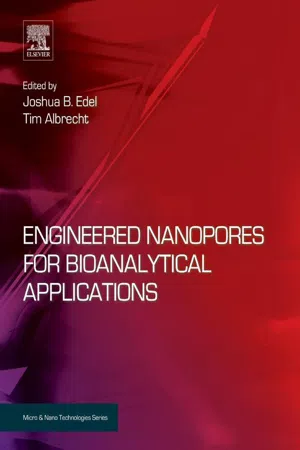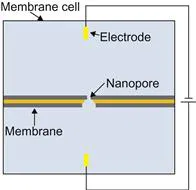
- 192 pages
- English
- ePUB (mobile friendly)
- Available on iOS & Android
eBook - ePub
Engineered Nanopores for Bioanalytical Applications
About this book
Engineered Nanopores for Bioanalytical Applications is the first book to focus primarily on practical analytical applications of nanopore development. These nanoscale analytical techniques have exciting potential because they can be used in applications such as DNA sequencing, DNA fragment sizing, DNA/protein binding, and protein/protein binding.This book provides a solid professional reference on nanopores for readers in academia, industry and engineering and biomedical fields. In addition, the book describes the instrumentation, fabrication, and experimental methods necessary to carry out nanopore-based experiments for developing new devices.
- Includes application case studies for detection, identification and analysis of biomolecules and related functional nanomaterials
- Introduces the techniques of manufacturing solid state materials with functional nanopores
- Explains the use of nanopores in DNA sequencing and the wider range of applications from environmental monitoring to forensics
Frequently asked questions
Yes, you can cancel anytime from the Subscription tab in your account settings on the Perlego website. Your subscription will stay active until the end of your current billing period. Learn how to cancel your subscription.
At the moment all of our mobile-responsive ePub books are available to download via the app. Most of our PDFs are also available to download and we're working on making the final remaining ones downloadable now. Learn more here.
Perlego offers two plans: Essential and Complete
- Essential is ideal for learners and professionals who enjoy exploring a wide range of subjects. Access the Essential Library with 800,000+ trusted titles and best-sellers across business, personal growth, and the humanities. Includes unlimited reading time and Standard Read Aloud voice.
- Complete: Perfect for advanced learners and researchers needing full, unrestricted access. Unlock 1.4M+ books across hundreds of subjects, including academic and specialized titles. The Complete Plan also includes advanced features like Premium Read Aloud and Research Assistant.
We are an online textbook subscription service, where you can get access to an entire online library for less than the price of a single book per month. With over 1 million books across 1000+ topics, we’ve got you covered! Learn more here.
Look out for the read-aloud symbol on your next book to see if you can listen to it. The read-aloud tool reads text aloud for you, highlighting the text as it is being read. You can pause it, speed it up and slow it down. Learn more here.
Yes! You can use the Perlego app on both iOS or Android devices to read anytime, anywhere — even offline. Perfect for commutes or when you’re on the go.
Please note we cannot support devices running on iOS 13 and Android 7 or earlier. Learn more about using the app.
Please note we cannot support devices running on iOS 13 and Android 7 or earlier. Learn more about using the app.
Yes, you can access Engineered Nanopores for Bioanalytical Applications by Joshua B. Edel,Tim Albrecht in PDF and/or ePUB format, as well as other popular books in Biological Sciences & Medical Technology & Supplies. We have over one million books available in our catalogue for you to explore.
Information
Chapter 1
Ion Transport in Nanopores
T. Albrecht, T. Gibb and P. Nuttall, Department of Chemistry, Imperial College London, Exhibition Road, London
Chapter Outline
1.1 Introduction
1.2 Brownian motion
1.3 Net transport of ions—the Nernst–Planck equation and its derivation
1.4 The conductance of a pore with uncharged walls
1.4.1 Cylindrical pores
1.4.2 Pores with noncylindrical geometries
1.4.3 Access resistance
1.5 The effect of surface charge
1.5.1 Charged surfaces in solution
1.5.2 The conductance of nanopores with charged inner walls
1.5.3 The ζ-potential of colloids and charged particles
1.5.4 Electroosmosis—fluid motion close to a charged wall in response to an external electric field
1.6 Particle translocation through nanopores—the model of deBlois and Bean
1.6.1 Small spheres solution
1.6.2 “Broad range” solution
References
1.1 Introduction
The transport of ions and other charged species, as well as liquid, is at the heart of any nanopore sensor, Figure 1.1. The flux of ions determines the electric current, which is often used as the sensing signal, but it also affects the liquid, for example in electroosmosis. Ion and liquid motion may also have an impact on the translocation of biopolymers through the nanopore, such as DNA or proteins, both in terms of the duration and magnitude of the concomitant ion current modulation.

Figure 1.1 Schematic of a nanopore sensor. The membrane separates the two liquid compartments of the cell with a single (or small number of) nanopore(s) allowing the exchange of ions and liquid. A bias voltage between two electrodes—one on each side of the membrane—allows electric field-driven transport through the nanopore. The current sensing electronics are not shown.
The fundamental physics of ion motion has been long established and forms the basis for the theoretical understanding of charge transport in semiconductor physics, electrochemistry, membrane science, and other areas. This chapter does not attempt to cover the vast area of electrokinetic fluid and ion transport but rather give a brief introduction into the main factors governing ion transport in nanopores with a focus on mean-field, dielectric continuum theory, and the Nernst–Planck equation. References to the more advanced literature are given where appropriate.
Simple models have the advantage that the resulting analytical expressions for the pore conductance Gpore and other parameters are transparent and potentially yield direct physical insight. Widely used “work relations” emerge from a relatively simple theory, which can be used to validate experimental data, for example, when assessing the pore dimensions. The lack of complexity, on the other hand, also implies certain limitations, in terms of quantitative accuracy and the validity range. For very small nanopores, in particular, where the pore size reaches “molecular” dimensions, the continuum model is expected to break down. Continuum theories have, however, an advantage compared to more sophisticated models and computer simulations in that they allow the entire electrochemical cell—including electrodes, electrolyte solution, and the membrane—to be treated with little extra difficulty. For example, in a conventional two-electrode system, the electric current is determined by the potential distribution in the entire cell, including potential drops at electrode/solution interfaces, the solution itself, and across the pore. If the pore is small and long, its resistance will usually dominate the total cell resistance and focusing on the pore itself is sufficient to capture all relevant features of the nanopore sensor. On the other hand, if the pore channel is very short—such as in graphene-based nanopores—the potential gradient between the electrodes and the pore openings is important and the so-called “access resistance” determines the overall pore resistance. This effect has been addressed already by Hille and Hall in the 1970s, who derive simple analytical expressions [1–3]. Finally, nanopore devices with multiple electrodes as potential current sources can readily be treated, as shown by Albrecht. However, careful consideration needs to be given to the limitations of the model used with regard to potential over-parameterization for example [4].
The Nernst–Planck, the Poisson, and the Navier–Stokes equations are known as the governing equations for the ion flux, local charge distribution, and fluid dynamics (momentum transport), respectively. At a higher level of complexity and accuracy, these are solved self-consistently for a particular geometry. The results are remarkably accurate but “only” numerical. Molecular-level detail may be included in Brownian or Langevin dynamics simulations at increasing computational expense. Detailed reviews on these more advanced topics may be found in Refs [5–7].
In order to understand the working principle, potential, and limitations of a nanopore sensor, we first need to look at the fundamental physical processes that underlie ionic and molecular moti...
Table of contents
- Cover image
- Title page
- Table of Contents
- Copyright
- List of Contributors
- Introduction
- Chapter 1. Ion Transport in Nanopores
- Chapter 2. DNA Translocation
- Chapter 3. Instrumentation for Low-Noise High-Bandwidth Nanopore Recording
- Chapter 4. Biological Pores on Lipid Bilayers
- Chapter 5. Solid-State Nanopore Fabrication
- Chapter 6. Case Studies Using Solid-State Pores
- Index